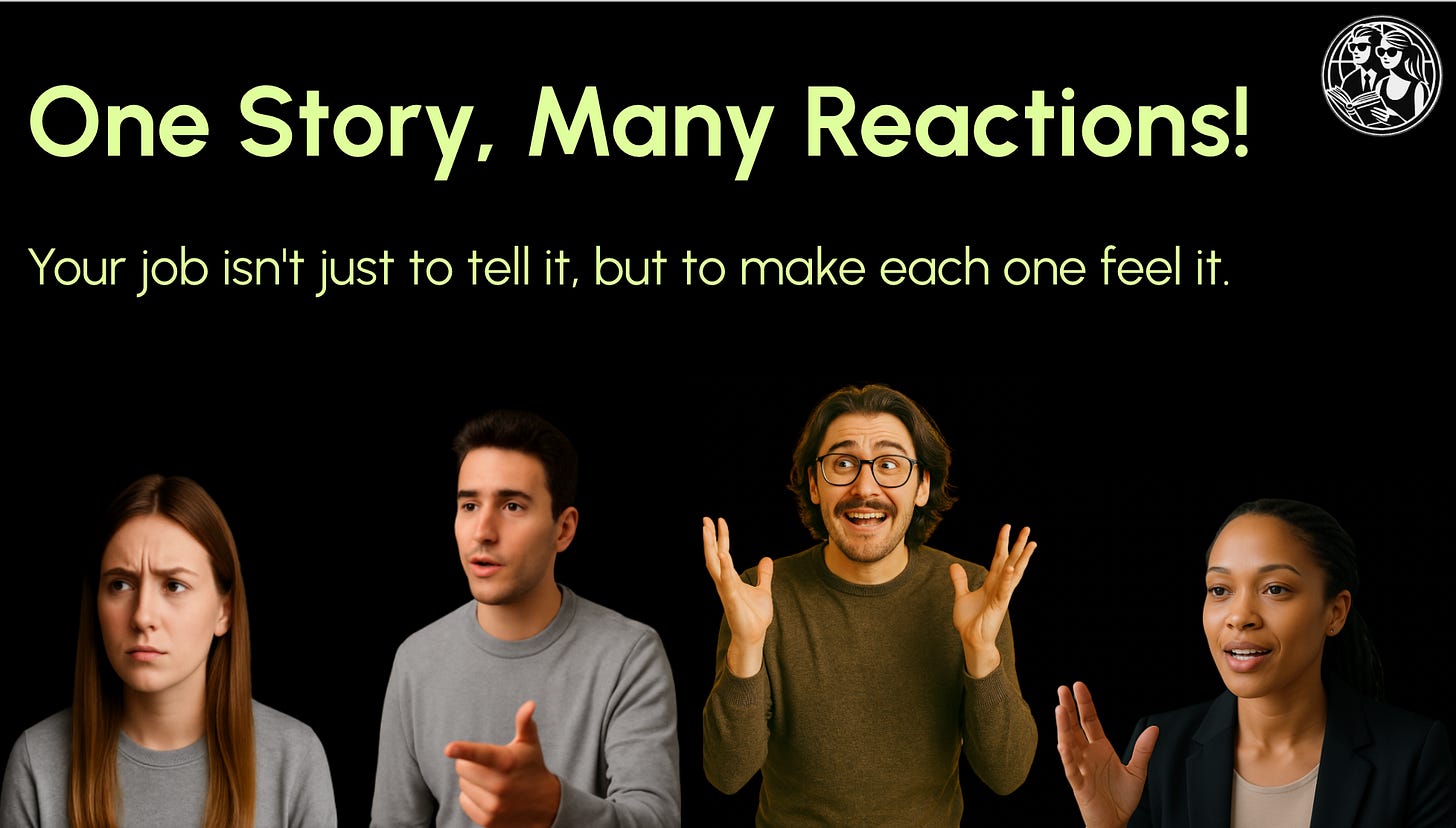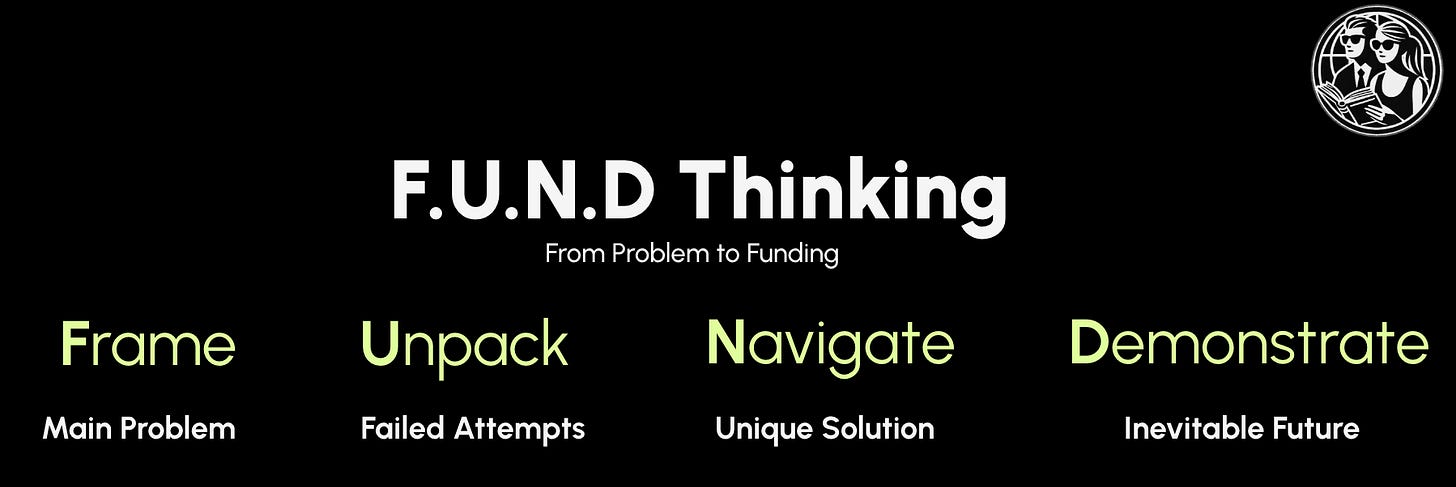From Problem to Funding 🤌
The founder story that turns investor doubt into belief.
Welcome to the final chapter of Product Voyagers' Sprint:
Storytelling in Product 🤌 → a 7-part hands-on series on turning product thinking into narrative mastery.
It's 12 minutes into your Series A pitch. The lead investor leans back, checks their phone, and asks the question that makes every founder's stomach drop:
"I still don't understand what problem you're actually solving."
You've just spent 12 slides explaining your product, your tech stack, your go-to-market strategy, and your impressive early metrics. But somehow, you never made them feel why any of it matters.
This isn't a product problem. It's a story problem.
And it's costing founders millions in missed opportunities every day.
What You’ll Learn to Win Investor Belief
Over the last weeks, I've been Entrepreneur in Residence at a top-tier accelerator, mentoring 27+ startups through their idea generation and fundraising journeys. I've sat through 45+ pitch rehearsals, watched brilliant founders stumble over their own stories, and seen the exact moment when everything clicks.
In this capstone article, you’ll master:
😰 Why Founders’ Storytelling Break Down
The common narrative traps that even brilliant founders fall into🎯 F.U.N.D. Thinking
A 4-part methodology that transforms feature dumps into inevitable futures📊 Investor Psychology Stack
A minute-by-minute breakdown of what’s happening inside an investor’s mind during your pitch⚡ Advanced Storytelling Techniques
Emotional pivots like “Day in the Life,” “Contradiction Reveal,” and “Inevitability Stack” that move your pitch from competent to compelling🤔 When Your Story Lands vs. When It Doesn't
Clear signals that show whether your story is working or falling flat
To keep this guide focused and digestible, several advanced tools and bonus breakdowns will be delivered exclusively via email FREE to all Product Voyagers subscribers 👇
Fundraising Narrative Arc
How your story should evolve from Pre-Seed to Series B+Your Next-Level Storytelling Toolkit
A 47-point narrative assessment to catch every weak spot before your next pitchThe Story That Launched a Unicorn
A Simple way to frame its story!The Ultimate Pitch Audit Checklist
With 47-point story assessmentYour Pitch Transformation Playbook
Including the 60-second story test and slide-by-slide story-first sequencing
😰 Why Founder Storytelling Breaks Down
What I've observed after sitting through dozens of founder pitches, both successful and... not so successful:
A Feature Trap: Founders get lost explaining what they built instead of why it needed to exist.
The Metrics Maze: They drown investors in numbers without wrapping those numbers in stakes and consequences.
The Solution First Fallacy: They lead with their brilliant solution before making the problem feel urgent and inevitable.
The Audience Amnesia: They forget that investors aren't just buying products—> they're buying stories about the future.
Sound familiar 👀 ?
If you've ever walked out of a pitch feeling like you "explained everything perfectly" but somehow didn't land the room, you know exactly what I'm talking about.
🎯 F.U.N.D. Thinking
After analyzing what separates funded founders from overlooked ones, I've distilled it into four narrative pillars that build on each other for a storytelling architecture.
Let's break down each pillar:
F – Frame the Inevitable Problem
"Why This, Why Now?"
Don't just describe a problem. Make it feel inevitable and urgent.
❌ Weak Framing: "Small businesses struggle with inventory management."
✅ Inevitable Framing: "Right now, there are 32 million small businesses in the US. Every single one faces the same impossible choice: tie up cash in inventory they might not sell, or risk running out of what customers actually want. This isn't a business problem—it's a survival problem. And it's only getting worse as customer expectations accelerate."
🪄 Storytelling Secret: Use the "Scale × Stakes" formula. Show the magnitude (32 million businesses) plus the consequence (survival problem) to make the problem feel both urgent and universal.
U – Unpack the Failed Attempts
"Why Haven't Smart People Solved This Already?"
This is where most founders stumble. They skip over existing solutions because they want to look unique. Big mistake.
Investors are thinking: "If this problem is so obvious, why hasn't someone else solved it?" Address this head-on.
✅ Smart Unpacking: "Smart people have tried to solve this. SAP built enterprise systems but they cost $200K and take 18 months to implement. QuickBooks added inventory features, however they're designed for accountants, not operators. Spreadsheets work until you hit 100 SKUs, then they become your biggest liability.
The problem isn't lack of solutions. It's that every solution was built for the wrong user, with the wrong constraints, at the wrong time."
🪄 Storytelling Power: By acknowledging existing solutions, you're not showing weakness → you're showing market validation. Then you explain why timing, technology, or approach creates a new opportunity.
N – Navigate to Your Unique Solution
"Here's What Changed Everything"
This isn't about features. It's about the unique insight that makes your approach inevitable.
❌ Feature Dump: "Our platform uses AI to predict demand, automate reordering, and optimize cash flow with real-time analytics and customizable dashboards."
✅ Insight Navigation: "Here's what we realized: small business owners don't want to become inventory experts. They want to focus on customers. So instead of building another dashboard, we built invisible intelligence. Our system learns from every transaction, every season, every trend and makes inventory decisions feel effortless.
When a local café owner can focus on creating the perfect latte instead of counting coffee beans, that's when you know you've solved the right problem."
🪄 Storytelling Technique: Lead with the insight ("they don't want to become experts"), then show how that insight shaped your approach ("invisible intelligence").
D – Demonstrate the Inevitable Future
"This is Where the World is Heading"
End with the future you're building toward. Make it feel both ambitious and inevitable.
✅ Future Demonstration: "In five years, every small business will have an AI-powered operations partner. Not because it's cool tech, but because the businesses that adopt it will outcompete those that don't. They'll have better margins, happier customers, and founders who can actually sleep at night.
We're not just building inventory software. We're building the operating system for the next generation of small business success."
📊 Investor Psychology Stack
Before we dive into advanced techniques, let's understand what's actually happening in an investor's mind during your pitch:
Minutes 1-3: "Is this worth my time?"
Minutes 4-8: "Do I believe this problem is real?"
Minutes 9-15: "Is this team uniquely positioned to solve it?"
Minutes 16-20: "Can this become a $100M+ business?"
Your story needs to guide them through each psychological checkpoint.
Advanced Founder Storytelling Techniques
1. The "Day in the Life" Opening
Start with a specific person facing your problem in vivid detail.
"It's 6:47 AM. Sarah is already at her bakery, not because she loves early mornings, but because she's counting yesterday's leftover pastries. Again. Twelve blueberry muffins that didn't sell. $36 in ingredients that became $0 in revenue. She'll throw them away and hope today's guess is better than yesterday's.
This happens 32 million times a day, in small businesses across America."
2. The "Contradiction Reveal"
Highlight the paradox that makes your solution necessary.
"Here's the contradiction that caught our attention: small businesses have more data than ever before, but they're making decisions based on gut feel. Every transaction is tracked, every customer interaction is logged, every trend is measurable—but the typical restaurant owner still eyeballs their potato order on Sunday night."
3. The "False Choice" Frame
Show how the market presents impossible options.
"Every e-commerce brand faces the same false choice: hire a $150K data scientist or keep guessing what to order. There's no middle ground. Until now."
4. The "Inevitability Stack"
Layer multiple trends that make your solution feel inevitable.
"Three things are converging right now: AI models that can predict demand with 94% accuracy, supply chains that can fulfill orders in 24 hours, and a generation of business owners who expect software to just work. When these three forces meet, inventory management transforms from guesswork to science."
The techniques are designed to carry your audience from interest to conviction, one emotional turn at a time.
Metrics That Matter in Your Story
Investors want numbers, but numbers without narrative are noise.
Let’s weave metrics into your story
Problem Metrics (Frame the Scale)
"32 million small businesses"
"$1.1 trillion tied up in excess inventory"
"43% of restaurants fail in their first year"
Solution Metrics (Prove It Works)
"94% demand prediction accuracy"
"Average 23% reduction in waste"
"Customers break even in 4.2 months"
Future Metrics (Show the Opportunity)
"$50B inventory management market"
"Growing 23% annually"
"Less than 5% penetration today"
🪄 Pro Tip: Always pair big numbers with human consequences. "$1.1 trillion tied up" becomes more powerful when you add "that's working capital that could hire 22 million employees instead."
Common Founder Storytelling Mistakes
Let’s try to avoid them ALL
Mistake #1: Leading with Solution
❌ "We built an AI-powered inventory platform"
✅ "Small businesses waste $50B annually on inventory mistakes"
Mistake #2: Buried Lede Problem
❌ Spending 5 slides on market size before explaining the core problem
✅ Hook with specific pain, then zoom out to market
Mistake #3: Generic Competition Slide
❌ "Our main competitors are Excel, QuickBooks, and SAP"
✅ "Smart companies have tried three approaches, and here's why each falls short..."
Mistake #4: Metric Soup
❌ Rattling off 15 different growth metrics
✅ Choosing 3 numbers that tell a story progression
Mistake #5: Weak Future Vision
❌ "We want to be the leading inventory solution"
✅ "We're building the operating system for small business success"
When Your Story Lands vs. When It Doesn't
You Know Your Story is Working When:
Investors ask about implementation, not explanation
They start talking about "when you scale" instead of "if you scale"
Follow-up questions focus on execution details, not concept validation
They introduce you to portfolio companies facing similar problems
The conversation shifts from "convince me" to "how can we help"
Red Flags Your Story Needs Work:
"I don't understand what you do"
"How is this different from [obvious competitor]?"
"Who actually has this problem?"
"What happens when [big company] builds this?"
Lots of questions, no forward momentum
From Story to Funding: The Final Mile
Your job isn't to explain what you've built. It's to help them see the world you're building toward, and make them want to be part of creating it.
The best founder stories don't just secure funding but they secure believers.
People who champion your vision in partner meetings, introduce you to key customers, and help you navigate the inevitable challenges ahead.
Remember: Investors don't fund products. They fund futures.
If this guide helped you see your pitch in a new light, then imagine what the full toolkit will unlock. 🤓
Want the complete Product Storytelling toolkit? This is Part 7 of our comprehensive course → dive into the full series for frameworks, templates, and advanced techniques that turn product people into master storytellers.



